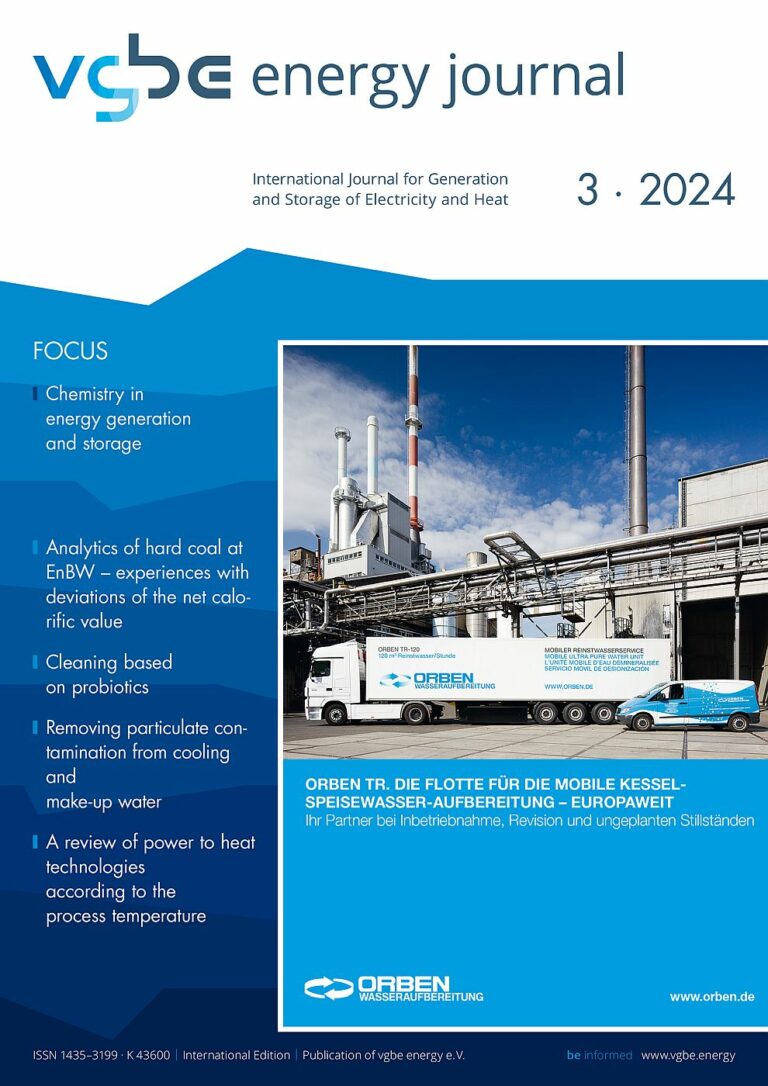Current and future challenges in power plant chemistry
Dr rer nat Anne Wiesel
The world of energy is changing. This also has an impact for the challenges facing power plant chemistry through the plans for changes in power plants. Both in the various vgbe committees and at the vgbe Chemistry Conference, it is noticeable that the topics in focus are changing.
In the last few years, there have been some important changes in conventional power plants, such as the lowering of flue gas and waste water limits, which are still affecting power plant chemists and lead to new tasks. In addition to the limit values themselves, in some cases the limits of determination of the measurement methods must also be lowered in some cases in order to be able to prove compliance with the limit values. Existing power plant units also need to be constantly optimised: The retrofitting of online measuring devices must be considered, as laboratory staff is generally smaller today than when the power plant units were built and laboratory measurements can therefore only be carried out at longer intervals in some places. Water treatment plants are often aging, resulting in higher maintenance efforts and a need for optimisation.
Analytics of hard coal at EnBW – experiences with deviations of the net calorific value
Anne Wiesel
Cleaning based on probiotics
Bianca Spindler and Kerstin Keppler
Due to a health risk to the population caused by Legionella in aerosols, only the hygienic operation of recooling plants/cooling towers and wet separators is allowed. This results in the annual use of 50,000 tons of biocides in cooling waters/ utility waters in the European Union. In order to understand microbiology of an aqueous system, the water phase as well as surface deposits and biofilms must be assessed. There is a particular correlation between these deposits and pathogenic microorganisms such as Legionella. Probiotics can naturally clean systems by metabolising these biofilms and establishing themselves on the surfaces. Through this cleaning process, microorganisms closely associated with biofilms often lose their habitat. In the medium term, this improves system cleanliness and hygiene in a sustainable and environmentally friendly way. In a clean system, there are fewer microbiologically induced problems.
Removing particulate contamination from cooling and make-up water
Friedrich Wilhelm
Nowadays, there are more filter systems than ever. In liquid-based cooling systems, for example, particle contamination is virtually unavoidable. Without appropriate treatment, these become increasingly concentrated and sooner or later lead to failures and sometimes costly damage to components and pipelines. While sand or multimedia filters are usually used to separate fine impurities such as turbidity, there is a wide range of automatic backwash filters to choose from for larger particles. Which filter system does the best job and when? What are the advantages and disadvantages of the systems? The application limits as well as the advantages and disadvantages of both systems are discussed. The article provides answers to these questions, taking into account both the technical possibilities and economic factors.
Using the remote diagnostic systems based on virtual environment and digital twins to lifetime assessment of power equipment
Jerzy Trzeszczyński, Marcin Hatłas, Wojciech Murzynowski and Radosław Stanek
The Polish energy system, despite investments in renewable sources, still relies predominantly on coal-fired power plants, with the largest group being the 200 MW class units. Many of these units have operated for over 200,000 hours, exceeding their designed operational lifespan. The further operation necessitate an individualized approach when assessing the technical condition of each specific unit. To successfully perform diagnostics and ensure availability of such devices, virtual (digital) diagnostic environments based on expert algorithms and digital twins can be effectively utilized. These systems enable the prediction of safe operation by conducting simulations on the depletion of durability reserves under the assumption of the most probable future operating scenarios.
A review of power to heat technologies according to the process temperature to be reached in the range from 40 °C to more 1500 °C incl. reachable technology efficiencies
Torsten Buddenberg, Sven Bosser and Emmanouil Kakaras
In the energy transition electrification of processes will gain importance to avoid indirect and direct greenhouse gas emissions of fossil combustion. As higher the process temperature is as more difficult the electrification is. All main technology routes will be mapped incl. their reachable coefficients of performance, their reachable temperatures. This will be compared to the use of fuel replacement by hydrogen or biogas and will be projected to the heat use in Germany. Also, power to heat to power will be discussed.
Operating experience with the MGT8000 gas turbine prototype in the evo plant at CHP plant 2 in Oberhausen
Christian Steinbach, Philipp Fockenberg, Karim Saidi, Stephan Dors,Oliver Keil and Sebastian Mombeck
Gas turbines are very efficient when used as combined heat and power (CHP) plants. Energieversorgung Oberhausen AG (evo) has been operating a newly developed gas turbine from MAN Energy Solutions SE (MAN-ES) since January 2021. This is a gas turbine with an electrical output of 8.9e MW and 34.1% electrical efficiency (at ISO conditions). The operation as a CHP plant increases the total efficiency to 90%. The plant and its integration into the local district heating network will be presented. The focus is on operating experience, such as startup behaviour and reliability, but also on issues encountered and how they were solved.
Additives for SOX separation, deposit and corrosion management in the boiler of WtE plants
Martin Sindram, Diethelm Walter and Frank Hernitschek
The use of lime- and dolomite-based additives – in existing stages or as an additional measure – is discussed. The focus here is on the use of these additives in the combustion chamber or in the boiler of waste-to-energy (WtE) plants. The use of lime products to desulphurise the flue gases in the boiler has a long tradition and is known as direct desulphurisation or the high-temperature dry additive process (HT-TAV). In many plants, SO2 has to be separated in addition to HCl. This article reports on current examples from practice. Possibilities for retrofitting existing systems and concepts for new systems are presented and performance data are analysed with special consideration of stricter limit values. The operating materials used are discussed with regard to their application and suitability.
The potential of carbon utilisation in a net zero emission economy
Qian Zhu
Achieving net zero emissions (NZE) requires diverse approaches for different sectors and a broad suite of technologies including electrification, hydrogen, sustainable biofuels and carbon capture, utilisation and storage (CCUS). Technologies for converting recycled carbon dioxide (CO2) into a value-added product are attracting increasing interest for their potential role in emissions mitigation and in a circular NZE economy. Carbon capture and utilisation (CCU) covers a wide variety of technologies and processes with varying levels of technical and commercial maturity, and differing mitigation potential across a range of applications. With its versatility of application and demonstrated effectiveness, CCU is a necessary element of the technology suite that must be deployed if the world is to achieve NZE.
Eurelectric position paper on governance of the energy union and climate action
eurelectric
Eurelectric welcomes the revision of the Governance Regulation and the discussion on the introduced tools, namely the National Energy and Climate Plans (NECPs). Eurelectric understands the Regulation as a central element of working towards the EU’s 2030 climate targets.
vgbe Conference “Thermal Waste/Sewage Sludge Treatment and Fluidised Bed Combustion 2023”
vgbe energy e.V.
The energetic utilisation of waste and sewage sludge as substitute fuel in conventional plants has been a tried and tested technology for years. The approximately 140 participants were offered an interesting lecture programme, which was accompanied by a trade exhibition.
Editorial

Dr rer nat Anne Wiesel
Head of Production Services
EnBW Energie Baden-Württemberg AG,
Altbach, Germany
Chair vgbe Technical Committee Chemistry & Emission Control
Current and future challenges in power plant chemistry
Dear readers of the vgbe energy journal,
The world of energy is changing. This also has an impact for the challenges facing power plant chemistry through the plans for changes in power plants. Both in the various vgbe committees and at the vgbe Chemistry Conference, it is noticeable that the topics in focus are changing.
In the last few years, there have been some important changes in conventional power plants, such as the lowering of flue gas and waste water limits, which are still affecting power plant chemists and lead to new tasks. In addition to the limit values themselves, in some cases the limits of determination of the measurement methods must also be lowered in some cases in order to be able to prove compliance with the limit values. Existing power plant units also need to be constantly optimised: The retrofitting of online measuring devices must be considered, as laboratory staff is generally smaller today than when the power plant units were built and laboratory measurements can therefore only be carried out at longer intervals in some places. Water treatment plants are often aging, resulting in higher maintenance efforts and a need for optimisation. Despite turbulent times, compliance with the required feed, boiler water and steam purity in the water-steam cycle in accordance with VGBE-S-010-00-2023-08 is still essential in order to avoid costly damage to the turbine and boiler. The challenges for the plant components are all the greater as we now have to deal with constant start-ups and shutdowns at unpredictable intervals. The aforementioned vgbe standard has also recently been revised to incorporate current aspects.
Particularly in the winter of 2022/2023, difficulties in the supply of chemicals led to additional work for the power plant chemists. In addition to the use of mobile reverse osmosis systems in water treatment to save on regeneration chemicals for the ion exchange systems, substitutes (e.g. for flocculants) and reduced qualities of auxiliary materials on offer also had to be evaluated. Preparations were also been made for the winter of 2023/2024 in this regard, but the measures did not materialise here.
New areas of work for the vgbe committees are mainly the result of the “fuel switch” projects and other new installations as part of the CO2 reduction measures. For example, biomass combustion and its influence on slagging and flue gas cleaning need to be considered, especially the challenge of switching to 100 % biomass. Other new projects include the planning of carbon capture and storage (CCS) facilities, where a lot of experience still needs to be gained. The planned “fuel switch” from coal to natural gas to hydrogen, both in existing plants and new builds, still raises numerous questions that power plant chemists need to think through. Large heat pumps, geothermal energy and electrolysis are other types of generation that are increasingly coming to the fore in the vgbe committees. For some topics, we are still in the early stages of defining all the important issues and gaining the appropriate expertise to develop new vgbe standards.
At the vgbe Chemistry Conference in Ingolstadt in October 2023, Mr Michael Rziha (PPChem AG) impressively lamented the loss of expertise in power plant chemistry in his opening speech. We are all called upon to value the knowledge of power plant chemistry and to ensure a suitable successor at an early stage. Knowledge can only be acquired through sufficient training and years of experience. It is also important to remember why power plant chemistry was originally developed – to prevent costly damage to the plants, for example through corrosion. Protecting the water-steam cycle and thus the steam turbine is also an important goal for new plants, especially if we want to achieve a high level of availability.
So, help us to network within the vgbe so that we can complement each other´s with expertise and tackle current and future challenges together!
